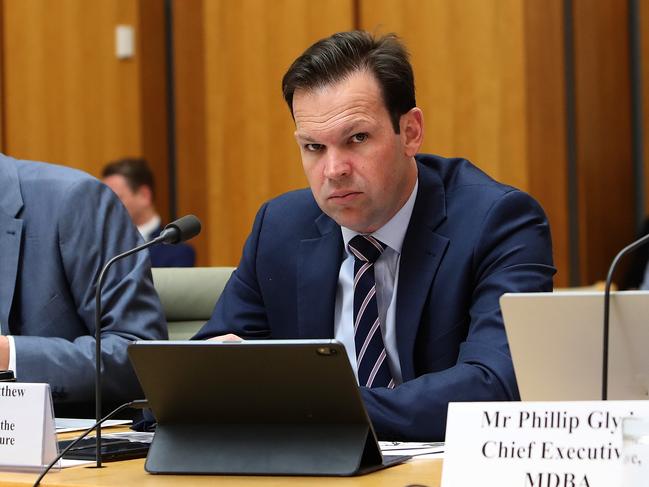Vikki Campion: Nice try but battlers DO expect bureaucrats to be accountable
When a senior bureaucrat explained that he didn’t expect a Net Zero Unit itself to be net zero, he merely showed how out of step the public service can be with the taxpayers who fund them, writes Vikki Campion.
Opinion
Don't miss out on the headlines from Opinion. Followed categories will be added to My News.
Canberra is the home of soiree virtue: It’s not what you do that matters, merely how you talk about it.
That’s why senior bureaucrats in charge of a $7m net zero unit can fly business class from their Melbourne home to their Canberra office every three weeks and not even worry about their emissions.
The boss of the Transport Department’s Net Zero Unit, Ian Porter, told senators he flew to Canberra one week in every three.
Not only has he never done a calculation of the carbon emissions of flying to Canberra every month, but he was working on establishing a full offset for flights across the whole of the public service with the Finance Department, which also had not yet set a standard.
The Net Zero Unit was budgeted $7.759m across four years to create a decarbonisation report, under the line item in the 2023-24 budget “reducing transport emissions measures”.

When the boss of the unit in place to reduce transport emissions had not even counted his own emissions for flying back and forth between Canberra and Melbourne — and his boss Jim Betts, the department secretary on about $1.6m a year, responded to a question with the words “nice try”, it was simply galling.
Here’s a taste of the transcript:
Senator Matt Canavan: “The Net Zero Unit is not yet net zero.”
Infrastructure Secretary Jim Betts: “You wouldn’t expect that. Nice try.”
Nice try?
Politicians go to an election to determine their fate and senior bureaucrats go to the exclusive Commonwealth Club. They are the government that never gets elected out and taxpayers foot the bill for that privilege.
For the rest of Australia living on planet prudence, working out their emissions on business class flights from Melbourne to Canberra would never be a problem because they would drive the seven hours instead.
If they did indulge in the spoils of a plane trip, it is with the tea and bickies at the back, not the G & T at the front.
Even if you calculated the carbon emissions at the top of the plane — where it is just four seats across compared to economy in six — the carbon emissions a square metre in economy are still less than business class, so live your virtue and move to the back.
Or better still, drive one of those electric vehicles you keep telling us about and that your department wants us to squeeze our families in at a cost of more than $70,000.
While Mr Betts may not have calculated the emissions, according to carbon calculator MyClimate, Canberra to Melbourne return in a business seat is 0.369 CO2 tonnes.
In an economy ticket, it is 0.287 tonnes and driving a compact electric vehicle the 1200km there and back would be about 0.162 tonnes of CO.
There it is.
You can answer with a smirk and an eye-roll Mr Betts but are you happy to collect your wage in your drive to force the rest of Australia to live a certain way.
At the same time, other parts of Australia can’t afford their power bill or their grocery shop.
People under a pitiless blue sky, in the drought that no one is talking about, are paying $2000 for a tank of water in cartage fees and graziers are getting paid as low as $2 for a sheep.
Pensioners don’t get change from a $20 note for a few lamb chops.
If the cost of living weren’t crushing so much of Australia, it would be simply annoying — but with people on more than $1m a year, it’s an example of the total disconnect between the pulpit and the parishioners.
Under scrutiny, the same department responsible for the transport transition revealed that in calculating its very important net-zero reports, they have not considered the entire life cycle of electric vehicles.
Just like the cost of electricity of a wind tower doesn’t include the transmission lines, or the now infamous Snowy Hydro 2.0, the cost of the electric vehicle only counts when it’s moving.
Even though they have 50 to 60 per cent higher emissions than an internal combustion engine during construction, the department, using selective economics, said: “Our analysis is on tailpipe emissions.”
When Senator Slade Brockman asked if they knew that one low-mileage EV being written off “could wipe out the carbon benefits for dozens, if not hundreds of cars”, they said they were aware of reports, but: “It has not been reported to us by our international peers.
“We have quite a close relationship with regulators in California, for example, who have not raised this issue with us.”
If the people in the home of flower power don’t think it’s a problem, why should we?
Senate estimates went on, with the Health Department admitting that it spent more than $3.5m on advertising half-price medicine, only to disclose that only some people would actually get it.
As if the plane ride wasn’t enough, the Infrastructure Department told the committee it spends $26,551.95 of taxpayers’ money on Welcome to Country each year.





